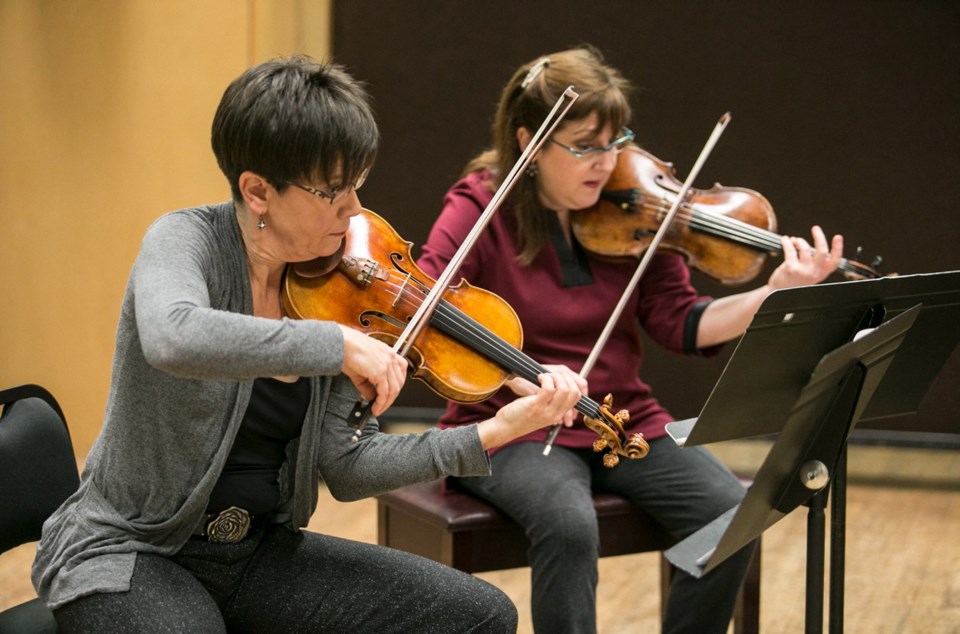PREVIEW
What: Lafayette String Quartet plays Shostakovich’s complete string quartets
Where: Phillip T. Young Recital Hall, MacLaurin Building, University of Victoria
When: Feb. 3, 4, 6, 8 and 9. All concerts at 8 p.m. Pre-concert talks at 7 p.m.
Tickets: $25 single ticket or $100 for a five-concert pass (250-721-8480 or tickets.uvic.ca or UVic box office)
During a rehearsal of the Lafayette String Quartet, Ann Elliott-Goldschmid remarked on Sharon Stanis’s bow-rapping technique.
“It’s not shocking me,” said Elliott-Goldschmid, the quartet’s first violinist. “I should feel like: ‘What is it?’ ”
“Oh, I’ll try it on the silver,” replied Stanis, the second violinist. She used the silver band at the end of her bow to produce a more percussive tap on the body of her violin.
“Yes!” Elliott-Goldschmid said.
Victoria’s Lafayette String Quartet was rehearsing Dmitri Shostakovich’s String Quartet No. 13. The music calls for a periodic rapping that sounds like door-knocking. After the practice, Stanis explained the composer lived through Josef Stalin’s regime when the creation of “subversive” art might attract a visit from the authorities.
“The knocking is like saying: ‘We’d like you to come into the van, please,’ ” she said.
Starting Friday, the Lafayette Quartet embarks on one of the defining projects of their 30-year career. Over five nights they’ll play all 15 of Shostakovich’s string quartets, composed from 1938 to 1974. They started rehearsing them together in early October, practising up to five hours on some days.
“It’s like running a marathon,” said Stanis, who later used another metaphor: “climbing a mountain.”
While not unheard-of, tackling the entire Shostakovich string-quartet cycle is uncommon. It’s a lot of music to prepare. And these quartets are not easily navigated, with their sometimes uneasy tonality and the composer’s fondness for mish-mashing different styles.
“In every single quartet there’s a technical challenge,” Stanis said.
She listed off a few elements found in the 15 quartets: “demonic waltzes,” “furious fast stuff,” “esoteric jazzy stuff” and “slow movements of great emotional breadth.” A single errant 16th note can send the whole thing off the rails, she added.
The other members of the quartet are cellist Pamela Highbaugh Aloni and violist Joanna Hood. Dressed casually in jeans, they practised in a ground-level studio at the University of Victoria. On the wall were vintage posters advertising Russian violinist Mischa Elman and the Alban Berg Quartet.
The four women, who formed their quartet in Detroit in 1986, worked through the String Quartet No. 13 meticulously, bar by bar. While always respectful, they spoke with a no-nonsense directness common to siblings.
“It’s supposed to be a double-piano you guys,” said Hood.
“Should my pizzs [pizzicatos] be louder?” Elliott-Goldschmid said. “Let’s continue because we want to go to the end of the movement before the day ends,” said Stanis.
“Come on you guys, don’t panic. Geez. It’s all going to be great,” Hood said.
Over the past decade, the Lafayette String Quartet has periodically pondered performing the Shostakovich string-quartet cycle. They want to do it for several reasons. One is to honour the late Russian violinist Rostislav Dubinsky, the quartet’s mentor in its early days at Indiana University.
Dubinsky was first violinist with the famous Borodin Quartet, renowned for its definitive recordings of Shostakovich’s string quartets. The scores the Lafayette Quartet use are marked with Dubinsky’s pencilled jottings. The Borodin Quartet had a close relationship with Shostakovich, who discussed the composition of his string quartets with them.
Stanis recalled a time early in the Lafayette String Quartet’s career — before Elliott-Goldschmid joined — when they lost their first violinist. Dubinsky, their teacher, offered to step in.
“He said: ‘Girls, do you mind playing with an old man?’ ”
Working intimately with a founding member of the Borodin Quartet was an invaluable opportunity for the young musicians. Stanis said Dubinsky was a “great man” with a wry Russian sense of humour who played with deep emotional conviction.
“Shostakovich was a nervous man. [Dubinsky] would imitate him. He would talk about how Shostakovich would take a melody and it really meant something political or personal. But it was veiled within the composition,” Stanis said.
She said one of the important pieces of wisdom Dubinsky passed along is that playing music is more than mere technical mastery. One must understand the emotional message behind the notes; one must convey what the composer was trying to say.
For neophyte listeners, five nights of Shostakovich string quartets (three per night, played in chronological order) might seem daunting.
Stanis said concertgoers might want to bear in mind that his quartets became progressively esoteric over the years.
“But they all have enough spice in them,” she said. “Even his second quartet, there’s a kind of craziness in it.”
